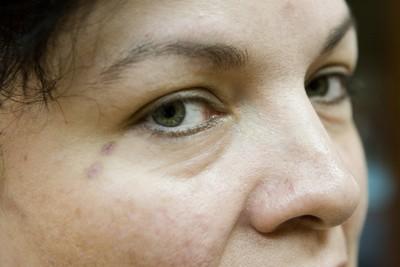Future looking good for former gang members

EStephanie Alvarez holds this truth to be self-evident: When people assume on sight that you’re scum, life sucks.
So it goes, she says, when you’re sporting tattoos that can mean you’re a murderer, ex-con or a gang banger.
"It’s a terrible way to have to live," the 40-year-old mother of five said before she headed to an appointment to remove teardrop ink marks near an eye. "It becomes almost impossible to get a good job or to even have a nice dinner at a restaurant. People look at you and they are sure they know what you stand for. It’s embarrassing to be treated worse than a leper."
Alvarez has dreamed for years of ridding herself of the stigma spawned by her gang-related tattoos.
One of her children told her about a program offered by Mary Arnold-Ronish, a former registered nurse who in May publicly offered to remove the tattoos of former gang members for free.
"I just can’t believe this is finally happening," Alvarez said, choking back tears. "Every time I think about it, it makes me cry. I could have never afforded to have 15 tattoos taken off."
Alvarez said she was pressured by family members, who were affiliated with a gang, into getting the tattoos, including two ink teardrops under her right eye.
Teardrop tattoos have various interpretations, one of which is that the bearer has committed a murder.
"I never killed anyone," Alvarez said. Nor, she said, has she ever been in prison.
Arnold-Ronish, owner of Professional Permanent Cosmetics on West Charleston Boulevard, said her tattoo removal program is a way for her to give back to the community.
"I think people deserve a second chance," Arnold-Ronish said.
That same kind of thinking prompted District Court Judge William Voy, who is responsible for juvenile delinquency cases in Clark County, to start a free tattoo removal program for juveniles trying to break away from gang affiliations.
"It’s not easy for young people trying to go straight to get the jobs and respect they want if they’re still wearing the marks of a gang," said Voy, who began the program last year.
One juvenile, who had been incarcerated on assault and battery charges, said his restaurant employer told him he had to wear Band-Aids on his tattooed fingers until he had his gang markings removed.
"It really hurts having the tattoos removed, but it will be worth it when I get them all done," said the 16-year-old waiter, whose tattoos are coming off via laser treatments in the offices of Dr. Julio Garcia, a plastic surgeon. "I won’t have a future if the tattoos can be seen."
Laser treatment breaks up ink particles into tiny fragments with highly concentrated light beams, a multistep process that can cause pain and blister formation as the fragments are cleared up by the body’s scavenging cells.
The technique used by Arnold-Ronish is different.
It involves using the same instrument that creates the tattoo. Instead of releasing ink or pigment, however, Arnold-Ronish inputs anesthetic. Sea salt paste is then added, which draws out the ink. Though the salt is largely cleaned out, it still draws ink into a scab, which is then removed.
"No matter which technique is used, more than one treatment is usually necessary," Arnold-Ronish said.
Though each procedure takes just a few minutes, Arnold-Ronish said the danger of scarring is always there.
Alvarez said many of her job searches have ended in frustration because of tattoos.
"I’ll apply over the Internet and everything will be fine; but when they see me in person with my tattoos, they ask me what I’m doing there," Alvarez said.
Alvarez is thankful that a retirement home for the elderly has hired her to cook.
"They were willing to look past my tattoos," she said.
Arnold-Ronish, who has worked with 25 former gang members since offering her free service, is working to remove "white power" tattoos from a young man.
"He heated a table knife and tried to burn them off, and that caused a lot of scarring," she said.
"I had to get rid of the white supremacist tattoos," the man explained, suggesting he could lose access to his child in a custody dispute if they remain.
Voy wishes more juveniles would take advantage of the tattoo removal program he worked out through the Clark County Medical Society. Upon a request from the society’s leaders, several doctors offered to participate.
To date, about half the 16 teens who began the program have decided to stay with it.
"I think the pain and peer pressure are problems," Voy said.
Garcia said he is happy to offer his services gratis.
"Kids have to know that they’re not going to get jobs with casinos if they’re wearing tattoos that can be seen," he said.
Alvarez knows it could be many months before Arnold-Ronish finishes removing all her tattoos.
"I just want to be like everybody else," she said. "These tattoos have been holding me back. All people are seeing is the front page of me, and that’s not fair. But you have to expect that in Las Vegas. This is a city based on looks, not intelligence."